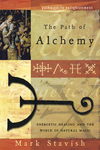The Path of Alchemy: Becoming Who You Are

Writing The Path of Alchemy has been a long and fascinating journey. The initial book was written a decade ago and finally came to light after a series of mishaps and out-of-the-blue phone calls from old friends and students. Over the decade between its initial creation and its final appearance in print, the The Path of Alchemy (along with myself as author) changed, grew, and improved quite a bit. This was and is a good thing; for authors need to be able to demonstrate the effectiveness of the methods they are proposing, not just write about them. Anything else is simply a research project and not a viable Path of Becoming.
My first encounter with alchemy was in the early 1980s, right at what was the end of Frater Albertus's Paracelsus College. Albertus had died and the College located in Salt Lake City, Utah struggled on for a year or two before closing its doors. Some of the College's alumni continued to teach privately, or semi-privately, such as at the Rosicrucian Order, AMORC's Rose-Croix University, but finding them in the pre-Internet age was nearly impossible. I had Albertus's and Manfred Junius's books and worked with what was available to me. A few years later I attended a seminar on alchemy sponsored by the now defunct French esoteric society The Philosophers of Nature, and the rest, as they say, is history.
It was not always clear to me why so many others and I struggled to understand alchemy, particularly when we were working in the dark on our own with only hints and suggestions to guide us. Jean Dubuis, chief author and founder of The Philosophers of Nature, stated that alchemy, unlike many occult arts and sciences, is one of the few that does not allow for personal illusions. Matter does not lie, the material world does not lie; alchemy is a perfect mirror of our inner state. Paraphrasing Paracelsus, Dubuis said that if we can transmute something in the material world, it is only because we have already transmuted the same energies and matter within ourselves.
That was it! With that simple explanation I understood why alchemy had become so important to me and to so many others. For too long we had met students and adepts of one form or another who in truth were fooling themselves about their own inner attainment. Alchemy offered a means of knowing unequivocally if we were going in the right direction or simply fooling ourselves. The Hermetic axiom "As above, so below; as below, so above" is not only a guiding principle but can be tested, just as any other Law of Nature.
What is equally fascinating about alchemy is the many levels of sophistication students can take it to, at least in its herbal aspects. The varieties of experiments to create tinctures, stones, and elixirs is phenomenal—all of which give positive benefits to the physical and psychic bodies of those who create and use them. Creating tinctures is not simply brewing a tea, but creating a veritable talisman that's consumable. It is the ancient rite of bread and wine enacted in a kitchen lab wherein the body and blood of the creator and user is transformed in small but noticeable increments.
For too long alchemy has been cloaked in darkness. Many who would have undertaken the alchemical path, or could have benefited from even a limited study of working with plants, were discouraged by the emphasis on working with minerals. Plant work (or spagyrics, as it is called) is the beginning, and for many, the end, of alchemy. Through it, the fascinating laws of nature known as Natural Magic are revealed to one's self.
In many ways, basic plant alchemy is ideal for just about everyone on an esoteric path. The knowledge required is often already present, only alchemical processes use this knowledge in a more efficient and direct manner. The methods and materials involved are inexpensive and readily available—dried or fresh herbs, canning jars, alcohol or distilled water, coffee filters, funnels, a kitchen stove, and an open heart and mind.
Adherents of traditional witchcraft, Wicca, and neo-paganism will see the forces of the Elements become visible and tangible. With only a nominal investment in time and energy, traditional teas, infusions and tinctures made for ritual, psychic or healing work can be demonstrably refined, strengthened, and improved.
Combining the methods of plant alchemy, ritual magic, and mysticism was something commonly done during the Medieval and Renaissance periods and in the early years of the twentieth century, when alchemy experienced a revival. While it would be imprudent to state the degree of consciousness I have experienced from combining these methods, it is safe to say that the methods have worked, as far as I am concerned. The techniques outlined in The Path of Alchemy for the creation of an alchemical product have had a dramatic effect on my interior and exterior life, and this is also true for everyone who has taken the time and effort to produce them.
Many of the spiritual questions that have puzzled students of esotericism for years have in time been revealed through a dedicated working with these simple methods. This is the most dramatic and common effect of using these alchemical techniques. I have been blessed, and I look forward to taking back more of the wisdom I have learned here on earth to Heaven.
Ora et labora!
About Mark Stavish
Related Products

is subject to certain Terms and Conditions